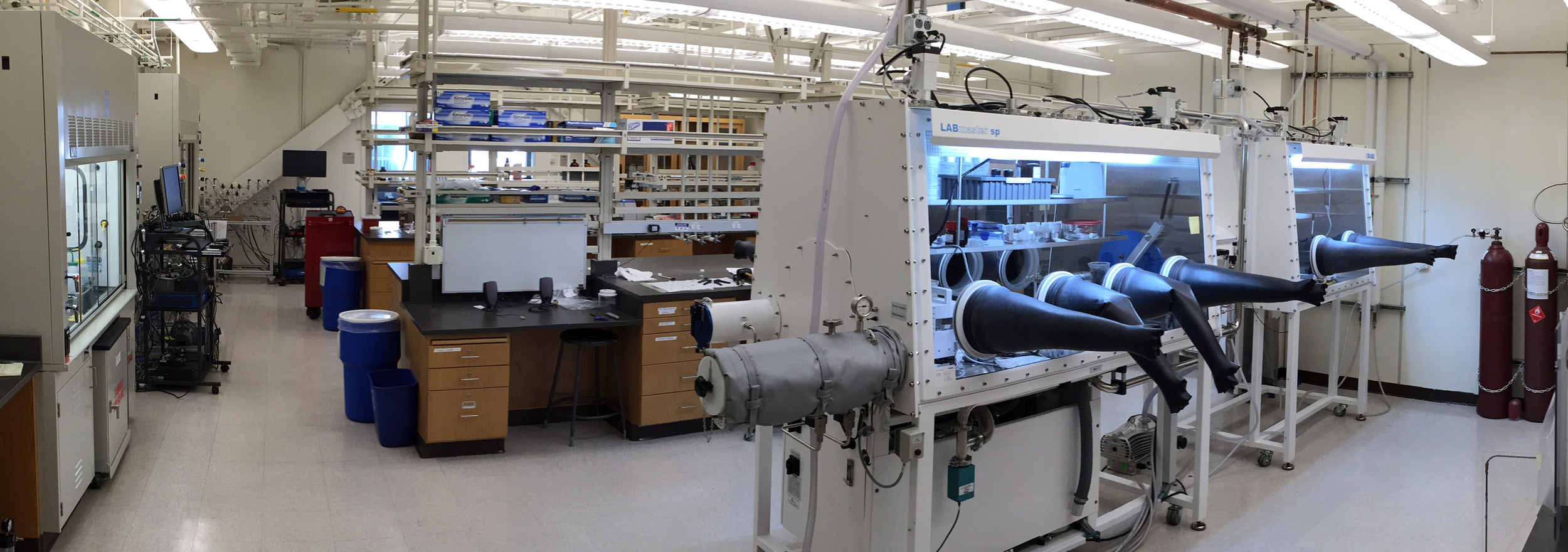The stability and performance of emerging Li-ion cathode materials
Representative publications: [Link], [Link], [Link], [Link], [Link], [Link]
The fast-growing electric-vehicle market has led to new challenges for state-of-the-art Li-ion battery cathodes due to the demand for increased energy density as well as the imminent supply issue of cobalt. New cathode chemistries that rely primarily on transition metals such as nickel and manganese have become an important goal to address these issues. Our lab is actively involved in various funded projects studying emerging cathode materials including structurally ordered nickel-rich layered oxides, partially cation-ordered spinel-like oxyfluorides, and cation-disordered rocksalts. The main drawback of these otherwise promising cathode materials is their long-term cycling instability. Our focus is to understand this limitation from two perspectives: cathode-electrolyte interfaces and bulk redox processes. Our lab utilizes our unique expertise in differential electrochemical mass spectrometry and a variety of specialized titrations to characterize in-situ outgassing, surface impurities, and bulk intermixed redox processes. With these advanced techniques, our goal is to provide clear correlations between material design, interface characteristics, deconvoluted redox capacities, and battery performance.
High Li ion transference number polymer electrolytes to enable high energy Li-ion batteries
*Image (left) created by Dr. Julie Rorrer
Representative publications: [Link], [Link], [Link], [Link], [Link], [Link]
In typical liquid electrolytes, most of the ionic current is initially carried by the anion, with a lithium ion transference number (t) ranging from 0.1-0.4 (i.e., only 10-40% of the ionic current is carried by Li ions). As a result of this low t, and in combination with the consumption/formation of the electroactive Li ions at the battery cathode/anode, salt concentration gradients are established within the battery in order to maintain electroneutrality, deleteriously affecting the battery performance. Specifically, as a battery discharge proceeds, the ionic concentration within the porous battery cathode, where Li ions are consumed, continuously decreases until it reaches zero at some shallow depth within the electrode, limiting the ultimate electrode thickness. High t electrolytes could significantly reduce, or perhaps eliminate, concentration polarization at high discharge rates, enabling thicker electrodes to be used, which would increase the ratio of electrochemically active battery components to passive cell components (such as the electrolytes), thereby increasing the energy density of the cell, particularly at high current rates desirable for electric vehicles. Our group works to understand the effect of various polymer properties, both chemical and physical, on the electrode/electrolyte interfaces and the polymer conductivity, thereby allowing us to optimize electrolyte composition to impart low impedance and enhanced Li-ion battery performance. This work includes both experimental development and testing of polymer electrolyte systems, as well as molecular dynamics simulations of these systems to understand the physical phenomena underpinning their performance.
Fundamental electrochemistry of metal-air battery chemistries for ‘beyond Li-ion‘ applications
Representative publications: [Link], [Link], [Link], [Link]
The lithium-ion battery is a truly remarkable technology; one which has found commercial application in numerous devices requiring portable energy storage. However, through decades of development, Li-ion batteries are now reaching physical limits in terms of the amount of energy they can store per unit volume. Our research will broadly focus on new battery chemistries that have promise to improve upon the energy density of Li-ion batteries. Among the many alternatives being explored, metal-air batteries possess very high theoretical energy densities, but suffer from poor rechargeability and Coulombic efficiency. Our laboratory’s specific focus will be to assess, and then address, the shortcomings of metal-air batteries through a systematic approach involving state-of-the-art electrochemical and spectroscopic characterization. Current projects include fundamental characterization of Na-air batteries and newly proposed Li-CO2 battery chemistries.

![The stability and performance of emerging Li-ion cathode materials Representative publications: [Link] , [Link] , [Link] , [ Link ], [ Link ], [ Link ] The fast-growing electric-vehicle market has led to new challenges for state-of-the-art Li](https://images.squarespace-cdn.com/content/v1/54bc60d4e4b0fee4b02b93e6/1475257293813-2GYBJ0UMTN5KVSKC3R5Y/Li-ion_Fig_website.png)
![High Li ion transference number polymer electrolytes to enable high energy Li-ion batteries *Image (left) created by Dr. Julie Rorrer Representative publications: [Link] , [Link] , [Link] , [ Link ], [ Link ], [ Link ] In typical liquid elec](https://images.squarespace-cdn.com/content/v1/54bc60d4e4b0fee4b02b93e6/1612393291491-74EPKY6DH9G5Q2PEWAF9/PE_image_website.png)
![Fundamental electrochemistry of metal-air battery chemistries for ‘beyond Li-ion‘ applications Representative publications: [Link] , [Link] , [Link] , [ Link ] The lithium-ion battery is a truly remarkable technology; one which has found co](https://images.squarespace-cdn.com/content/v1/54bc60d4e4b0fee4b02b93e6/1541115396283-WLK7ZC33RLME5YPDCKFK/Li_O2_website.png)
Enabling ‘extreme‘ fast-charging of Li-ion batteries
Representative publications: [Link], [Link]
Despite recent growth, consumers are slow to adopt electric vehicles, in part due to long charging times. As a result, the U.S. Department of Energy has set an ambitious goal for designing a lithium ion battery (LIB) pack that can withstand a 200 mile charge in only 10 minutes. Our group is part of the DOE Vehicle Technologies Office XCEL Fast Charging program working towards this goal, specifically aiming to understand unique battery chemistry challenges that arise during fast charge. We have developed techniques to detect and quantify a degradation reaction known as ‘lithium plating’ that occurs at the graphite anode. These techniques include ex-situ mass spectrometry titrations (MST) of cycled electrodes, in-situ voltage and coulombic efficiency analysis, and in-operando impedance spectroscopy. With expertise in reliably detecting Li plating, we plan to a) continue developing additional techniques that could be applied in vehicles and b) move towards electrode and electrolyte composition engineering to design better batteries for fast-charging.